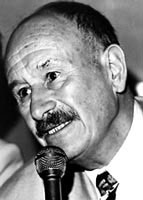David Bernstein: Back to the drawing board
The golden age of the poster is deemed to be over, however, David Bernstein had an opportunity to reminisce about it during his recent summer holiday

while on holiday in France, instead of searching between the showers for a topic for Design Week, I allow serendipity to take over. And sure enough, just a few kilometres down the road, a small chateau is playing host to an exhibition of posters. It features mainly classics from either side of World War ll. Michelin, Bally, Cointreau, Orangina, Perrier. Familiar friends alongside new discoveries.
I open the local newspaper and, voilà , a piece on Raymond Savignac, ‘le plus grand affichiste français de sa génération’, according to poster guru Alain Weill. Savignac is known for Monsavon au lait (bar of soap plugged into the udders of a cow), Dunlop (motorist driving, not a car, but four tyres and a spare), Aspro (line of traffic coursing through the sufferer’s head).
But this is no retrospective, let alone an obituary. Savignac is still working at the age of 93. An inhabitant of Trouville in Normandy since 1979, he has just had a street named in his honour. Promenade Savignac will display 24 of his designs.
But is all this serendipity? No, not really. In France, design and ideas have a higher profile and a more intense public following than they do in the UK. I can’t imagine a British castle showcasing posters or a seaside town naming a street, say, Gilroy or Games.
Savignac, says the article, defined poster art as ‘the creation of fleeting images which people don’t forget’. The discipline is not space (what could be bigger than a wall?), but time, the few seconds in which the passer-by passes by a poster or, in the case of a bus site, vice-versa.
Savignac became an assistant to his idol Cassandre (Nord Express, Normandie French Line, Dubonnet) and learned to make large uncompromising designs for the most part in primary colours but, whereas his mentor showed respect for his subject matter, Savignac made gentle fun. Cinzano is a pantomime horse, Dunlopillo is half man, half mattress and the newspaper Il Giorno is a window about to be pushed open by a man in pyjamas.
Few of his designs need much, if any, text. As Weill says, ‘The poster should be sufficiently clear in its message to render all text superfluous.’ His designs lack subtlety, but not wit. In an attempt to prevent the construction of a motorway through Paris he places, in the midst of a traffic jam of black cars, a beleaguered, angled Notre Dame, its spires projecting hands in abject surrender.
I mustn’t give the impression that great poster art flourishes in France. The standard is no better than here. Savignac, alas, represents a dying breed, a defiant bastion opposing, in Weill’s words, ‘Interminable brain-stormings… with the joyous creativity of the solitary artist. To the verbiage of slogans he responds with the purity of the image.’
A lost cause perhaps, but not forgotten, at least in France. Towns and villages rarely seem to be in a hurry to remove old enamel signs, and those that are taken down fetch good prices. Painted walls were the fashion between 1920 and 1960, but meander down minor roads and vestiges of them catch your eye.
The most remarkable was Cassandre’s DUBO DUBON DUBONNET. The story bears retelling. He was lettering the brand name (artists used to do such things) when the phone rang. He returned to the drawing board and saw the unfinished word DUBO, beau – beautiful. DUBON, bon – good. Last month just north of the Loire I saw a faded remnant of the brand name on the side of a farmhouse, just the letters DUBO.
Savignac’s fellow assistant in the Cassandre atelier was the artist André François who believed that a poster ‘should first of all be totally different in style, design and idea from its neighbours and competitors’. How many contemporary posters can check off all those criteria? ‘Neighbours’ is important: bearing in mind where the poster is situated, what nearby is likely to impinge on the design?
If the poster artist is no more and classic designs are entombed in chateaux, we may wonder if there ever was a golden age. Weill is realistic. He has judged more poster competitions than I’ve had diners chauds and asserts that in every decade the submissions were mostly merde.
This month Weill is a judge at the Outdoor Advertising Association of America Awards in New York. I’ll let you know what he thinks of this year’s crop.
-
Post a comment




